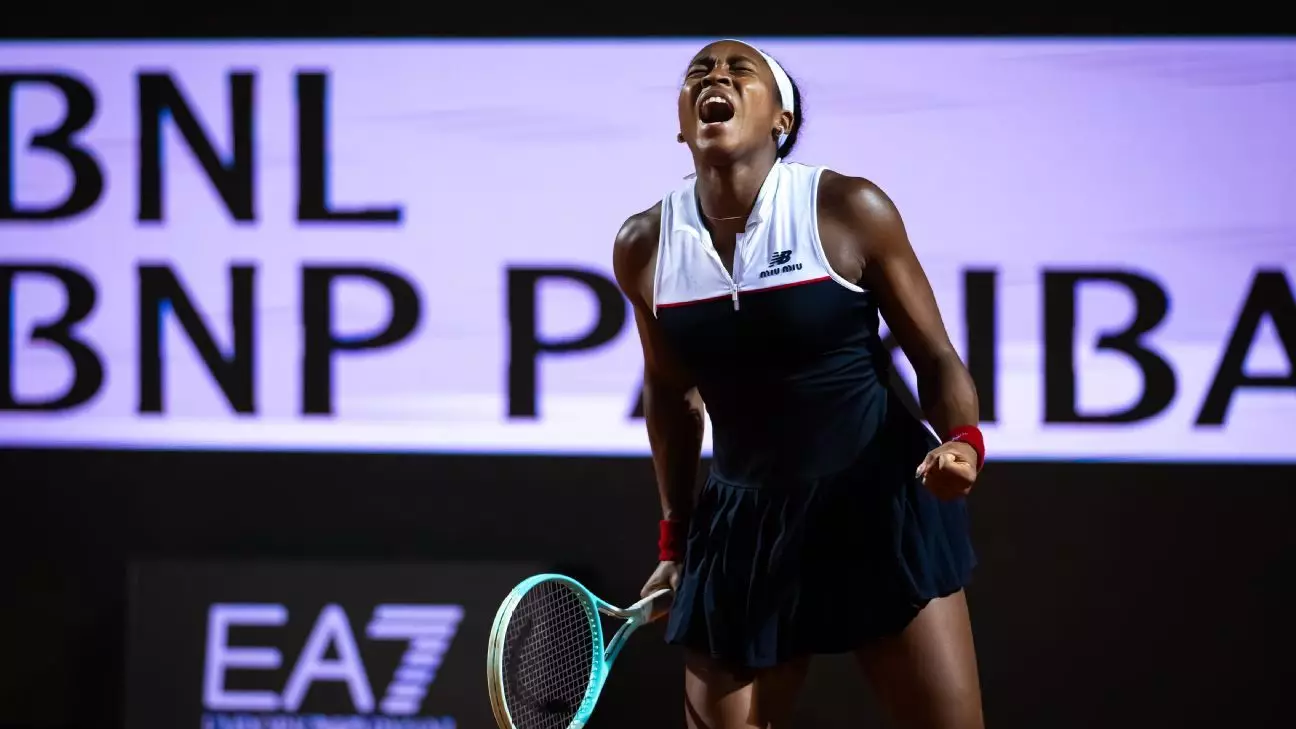Coco Gauff has firmly established herself in the realm of elite tennis after reaching her first final at the Italian Open, a milestone underscored by her intense semifinal clash against Zheng Qinwen. Their match was a rollercoaster of emotions that entered a grueling marathon, lasting over three and a half hours and culminating in a nail-biting 7-6 (3), 4-6, 7-6 (4) victory for Gauff. The match exemplified the unpredictable nature of sport, where momentum can shift like a pendulum, and perseverance becomes paramount.
Gauff exhibited remarkable mental fortitude throughout the match, particularly when faced with setbacks. Leading 5-3 in the first set, she allowed Zheng to claw back, highlighting the mental games that often define matches at this level. The eventual edge Gauff gained in the tiebreak showcased her ability to capitalize on Zheng’s double faults and erratic play, even amidst a staggering 35 unforced errors collectively between them. This was not just a display of physical skill; it was a testament to her resilience, demonstrating that in high-stakes situations, mental strength can be as crucial as technical prowess.
The Home Advantage for Paolini
On a parallel note, Jasmine Paolini’s journey to the final marks a historic achievement as she becomes the first Italian woman to reach the Italian Open final in a decade. Her semifinal win against Peyton Stearns, sealed with a score of 7-5, 6-1, revealed her ability to rise from adversity, having initially fallen behind in the match. Paolini’s victory is a beacon of hope for Italian tennis fans, offering a refreshing narrative of a local talent making waves on home soil.
How Paolini managed to turn the tide against Stearns was not just about her skills on the court, but also her connection with the local crowd. After facing an uphill battle in the initial games, her eventual turnaround sparked a collective roar from the audience, filling her with the psychological boost to complete her comeback. In her post-match comments, she expressed gratitude for the support of the crowd, highlighting the symbiotic relationship between a player and their fans—a dynamic that can often be a game-changer in critical moments.
Lessons in Comeback and Confidence
Both Gauff and Paolini’s matches highlighted a crucial lesson in the realm of sports: comebacks are rarely linear. They require grit, an almost unyielding spirit to withstand pressure, and the will to flip the narrative when things seem dire. Gauff’s subsequent victory in the tiebreak, after a fluctuating performance, serves as a reminder that maintaining composure in the face of adversity defines champions. This was particularly relevant in light of her previous runner-up finish in Madrid, which casts an additional layer of significance on her current pursuit for the title.
On the flip side, Paolini’s story reflects the classic adage of “it’s not where you start but where you finish.” Her initial struggles against Stearns didn’t deter her from harnessing her inner strength to secure victory. Fans witnessed a transformation that extends beyond mere athletic ability; it’s a manifestation of a player’s mental preparation, adaptability, and ability to bounce back when faced with challenges. As she celebrated her hard-fought win, it was clear that her journey resonated deeply with the crowd and would continue to inspire up-and-coming athletes.
The Stage for Future Stars
The final showdown between Gauff and Paolini at the Italian Open is not merely a match; it is a meeting of fresh talent on a grand stage. The spirit of competition will be electric as two players, each with compelling narratives, vie for the coveted title. For Gauff, it’s about solidifying her status amongst the elite after a tumultuous yet revealing season, while Paolini gets the chance to fulfill the dreams of her nation and carve a niche for herself in history.
As the final approaches, fans of the sport are reminded of the passionate stories that unfold on the tennis court. Each match carries the weight of not just the players’ skills but their struggles, triumphs, and connections with each other and the crowd. It’s that rich tapestry of narrative that keeps audiences captivated, inviting them to root for their favorites while cherishing the spirit of the sport itself. The emotions, the drama, the thrill—it all converges at the apex of competition, unveiling the essence of what makes tennis so captivating.


Leave a Reply